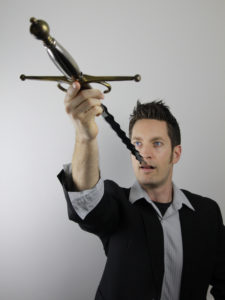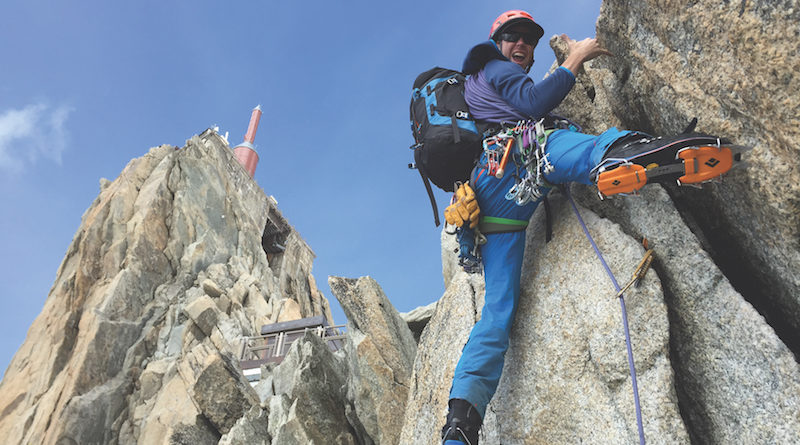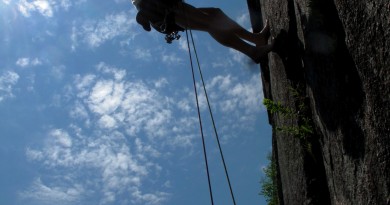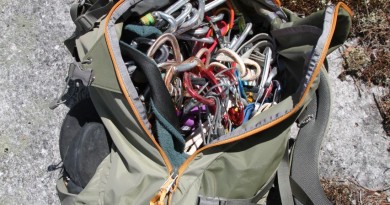How to Harness Your Fear
Whether you’re a rock climber, whitewater paddler or sword swallower, at some point you have to contend with fear. With practice, it can be your greatest performance aid.
Two days after Christmas in 2018, Steve Charest, 39, experienced any climber’s worst nightmare: a catastrophic anchor failure that sent him plunging six stories down an ice flow.
The owner of Petra Cliffs—a Burlington-based climbing gym and international guiding company—was wrapping up a day of guiding introductory ice climbing in Smugglers’ Notch. As he had done hundreds of times before, he climbed the final route of the day to the anchor he had built at the top of a 60-foot route known as the Workout Wall, digging ice axes into solid ice as he made his way up the frozen flow.
“I transferred my rope to the fixed anchor that was on the tree. It was redundant, it had a knot and a locking carabiner. I assessed it for damage, running my hand around it, as I had the dozen or so other times I had climbed at that site earlier in the month,” recalls Charest, an American Mountain Guides Association-certified rock, alpine and ski guide who has been climbing since age nine. Then, having deemed the anchor safe to lower off of, he disassembled the anchor he had built himself, transferred his full weight onto the fixed anchor, and told his client to lower him. “At some point during the process of lowering, the fixed anchor failed,” he says.
Charest plummeted 60 feet to the ground. The impact crunched bones in his face, left wrist and ankle, fractured his skull and caused internal damage to his abdomen. An injury to his pituitary gland wiped away his memory of the day—or any day between December 27, 2018 and February 1, 2019. He spent seven weeks in the hospital, tackling each decision about his recovery like he was navigating a meandering and unyielding alpine climb.
“No one knew whether I would have the same mental functioning I did before my injury. It was a real question as to whether I would be paralyzed or not. The mountaineer in me was like, ok, this situation is not acceptable. So how do I climb off the mountain? How do I get back to base camp and normal?”
Dealing with fear is a big part of the answer.
Charest has taught hundreds of people to climb and ski in the backcountry. Notable mentees include Aaron Rice, a University of Vermont graduate who set a world record in 2018 by skiing 2.5 million vertical feet in a year; Backcountry Magazine editor Tyler Cohen; and Taylor Luneau, policy manager for the American Alpine Club.
But Charest, whose Petra Cliffs camps will introduce 550 local kids to climbing by the end of summer, is now facing some of the same challenges he’s grown so skilled at teaching others to overcome.
“Because I’m recovering from a traumatic injury that I sustained doing something I’d done safely 100,000 times, I’m working through some of the same fears our summer camp kids face,” says Charest.
Repetition has been a key part of overcoming those fears. Charest has practiced cleaning an anchor—the act that led to his fall—over and over again since getting back on rock in April. “It’s not that I don’t trust the equipment or the systems, it’s that I’m learning to trust myself again.”
Harnessing the Power of Fight or Flight
The fear of falling is one of the most common fears people face in any sport, whether it be rock climbing or paragliding, where the consequences can be fatal, or resort skiing and mountain biking, where a fall is more likely to result in bone breaks and bruises.
But fear, a natural instinct that goes hand in hand with self-preservation, does have its benefits.
“Fear is our friend,” says Calef Letorney, a paragliding instructor at Paraglide New England. The former whitewater kayaking national champion and Westford native has made a career out of helping people learn to fly safely. “Fear is an important teaching tool—listen to it. The key is to work on the basics so much and keep your performance within your skill level so that when it’s time to do something more challenging, you can use that input to make a logical decision.”

Bud Keene, the freeskiing and snowboarding coach from Vermont who helped snowboarder Shaun White rise to Olympic glory, sees other benefits. Keene, who is also an accomplished climber, works with athletes—many of whom are Olympic caliber—to help them figure out how to use fear to reach the next level. In a 2016 article in VT SKI + RIDE, Keene says:
“To most people, the queasy feeling that they get in their gut before dropping into something new is interpreted as a bad thing. That couldn’t be further from the truth! Here’s the reality, and what I tell my athletes: The butterflies are the adrenaline pouring into your system that prepares you for what you are about to do. Adrenaline is a powerful natural stimulant that, once released into your system makes you stronger, quicker and more capable. Your body is making sure that you have the best chance for success.”
Fear, as we experience it, starts in the amygdala, a little set of neurons buried deep in the temporal lobe of our brain. It may come as no surprise that the amygdala has also been shown to play a key role in the way we process emotions. According to one 2002 report published in Dialogues in Clinical Neuroscience, the fight-or-flight response Keene is describing triggers an increase in heart rate and blood pressure. It can cause your pupils to dilate, your brain to become hyperalert to your surroundings, and increases blood flow to your skeletal muscles—the ones that help you make your next move. The key, says Keene and other expert coaches, is to train your brain so you don’t let those feelings distract you from the task at hand.
But fear can also be paralyzing. Burlington climbing guide Roderick Russell, who works alongside Steve Charest on the board of CRAG-VT, says fear is something every extreme athlete has to reckon with. “I had a pretty bad childhood that forced me into some uncomfortable situations and I had to learn to deal with challenging thoughts. As an adult, I started pursuing progressively more difficult and dangerous skill-based activities to try to explore that skillset further,” he says.
Russell, an AMGA-certified single pitch instructor in rock climbing, is also a master sword swallower (one of about one hundred in the world, according to the trade organization Sword Swallowers Association International). With a Masters’ degree in philosophy from the University of London, he’s also a licensed hypnotherapist who travels nationwide teaching workshops about how to build the mental toughness necessary to thrive at the edge of one’s comfort zone—whether in a corporate board room or climbing a peak.
“In performance circles, sword swallowing is sort of described

as the Holy Grail of mind-over-body stunts,” he says. According to Russell, who can swallow two swords at a time, “You have to be really determined to physically get a sword down your throat because you’re coordinating a lot of muscle groups at once to do something that goes against basic human instinct and is painful.” One involuntary muscle twitch or reflexive gag and you could die. For Russell, it took a year and a half of practicing three times a day to get his first short sword down.
Today, he’s swallowed swords on more than 3,000 stages for more than 2 million people, on beaches in Thailand and once on a moving train. Every time he does it, he still experiences fear. “It never goes away and it will come back when you need to focus the most.”
Russell has trained himself to notice fear’s onset and to hone cognitive skills to respond to the information fear offers him when it arises. When it does, he deploys a set of what cognitive-behavioral therapists call “self-distancing techniques” to remove himself from the emotional response his fear inspires. It’s a technique most often used in a clinical psychotherapy setting to help people move past the emotions triggered when they revisit past traumatic experiences, so they can look at those experiences analytically.
For example, when Russell chokes up on a climb or feels fear creep into his synapses while swallowing a sword, he frequently deploys something called the “scientific observer” method. “Pretend you are a scientist reviewing the scene before you with an objective, analytical eye, noticing your fears as they come into your mind. What are the potential risks you see? How likely are they to occur and if they did, what would be the outcome? If the scenario passes this test, I proceed with confidence,” says Russell. If you decide that your fear is giving you good, objective feedback that it’s time to back off a climb or re-evaluate your route, you listen to it. In either scenario, you return your focus to the task immediately ahead of you.
Other techniques Russell employs and teaches include naming thoughts, thanking them and saying, “I’m having the fearful thought that…” rather than “I am scared.” As a guide, he walks clients through ways to use these tools while they’re on the rock.
The practice appears to have some grounding. One 2015 study from Clinical Psychological Science found that veterans diagnosed with PTSD who employed these strategies when asked to revisit their traumatic memories showed less of an increase in heart rate and other physiological stress responses. Still another study published in Frontiers in Psychology in 2018 showed that participants who employed the “scientific observer” self-distancing technique in a laboratory setting were more likely to make logical judgements about a series of lotteries in a way that allowed them to maximize a cash reward.
Russell is not a licensed cognitive behavioral therapist, but he says he’s seen these tools work for himself and others. “I think the key is that you don’t try to control the fear,” says Russell. Instead, he focuses on the task ahead of him. As a guide, he aims to help others do the same. As a result, he says, “I am an incredibly safe climber and I am the safest sword swallower I know.”
As for Charest, he’s re-examining his own relationship with risk and hopes to keep helping others build confidence in their ability as he does. “It’s the process of re-learning to trust myself that can be frustrating,” he says. His goals are two-fold: to get physically and mentally fit enough to finish his IFMGA certification and to someday climb Mt. McKinley, officially renamed Denali in 2015, with his two-year-old daughter, who’s named for the 20,146-foot peak. “Recovery has been a real test of the skills I’ve built so far as a skier, a climber and a guide.”
Looking for some expert advice about how to deal with fear in the outdoors? Check out 6 Ways to Make Fear Your Friend.
Steve Charest and Roderick Russell will both speak at the inaugural Vermont Climbing Festival, Sept. 20-22 at Cochran’s Ski Area. For more climbing-specific fear management tools, sign up for Russell’s clinic, “On the Edge: Mental Training for Climbers.”
Featured Photo Caption: Though he’s climbed all over the world, Petra Cliffs co-owner Steve Charest, shown here in Chamonix, has put up plenty of first ascents in Vermont. His latest, a three-pitch traditional climb up the Quartz Crack Face in Smugglers’ Notch, goes at 5.12c or 5.13. Now, he’s facing his biggest challenge yet. Photo courtesy Steve Charest



